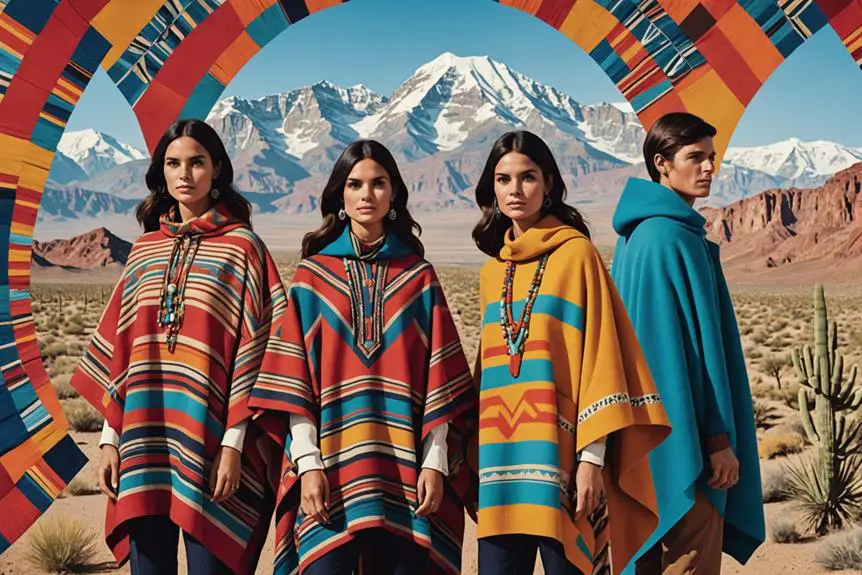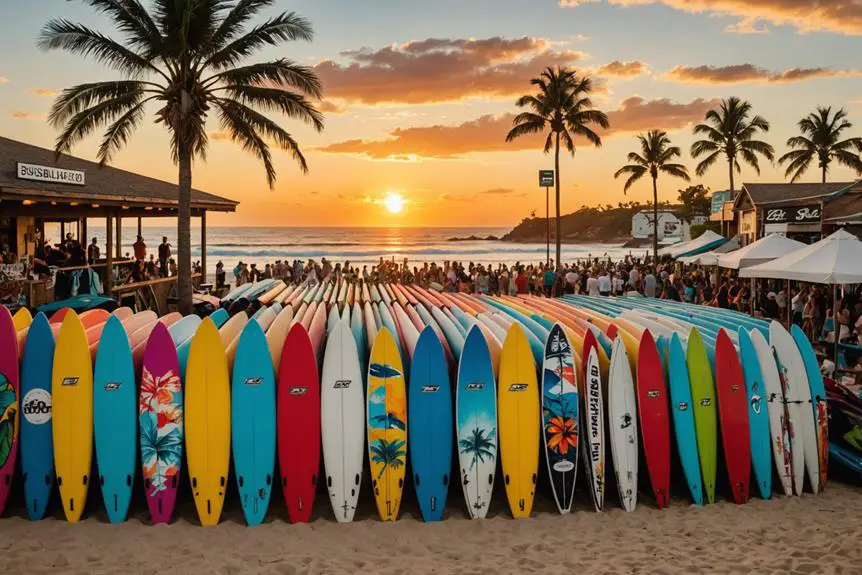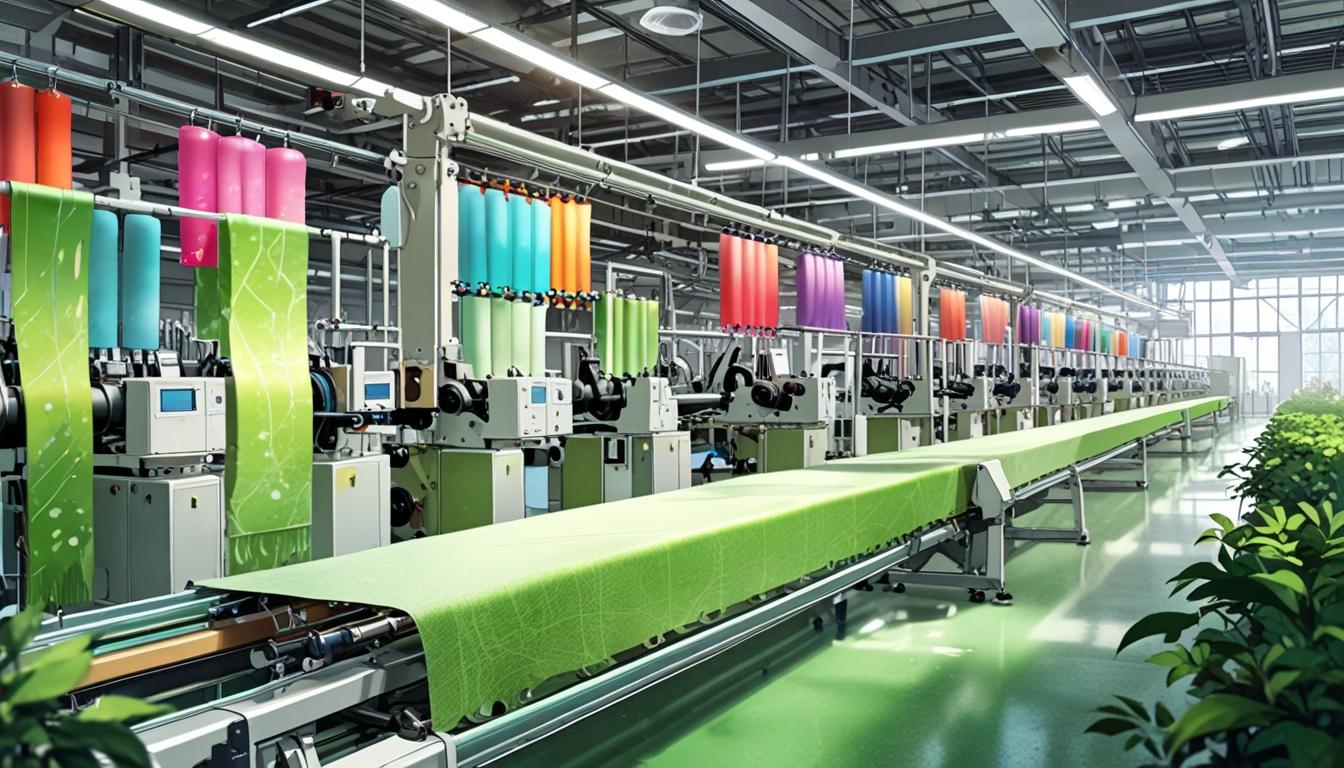Like a tapestry woven through time, the poncho tells a story that spans over a millennium. You might not realize that this simple garment has roots in the ancient Andes, where it served purposes far beyond mere fashion. From its cultural significance among the Paracas people to its evolution into a contemporary style staple, the journey of the poncho is rich with meaning. What's even more intriguing is how its design reflects social status and identity, hinting at deeper connections within communities. So, what other layers might this versatile piece of clothing reveal?
Etymology of the Poncho
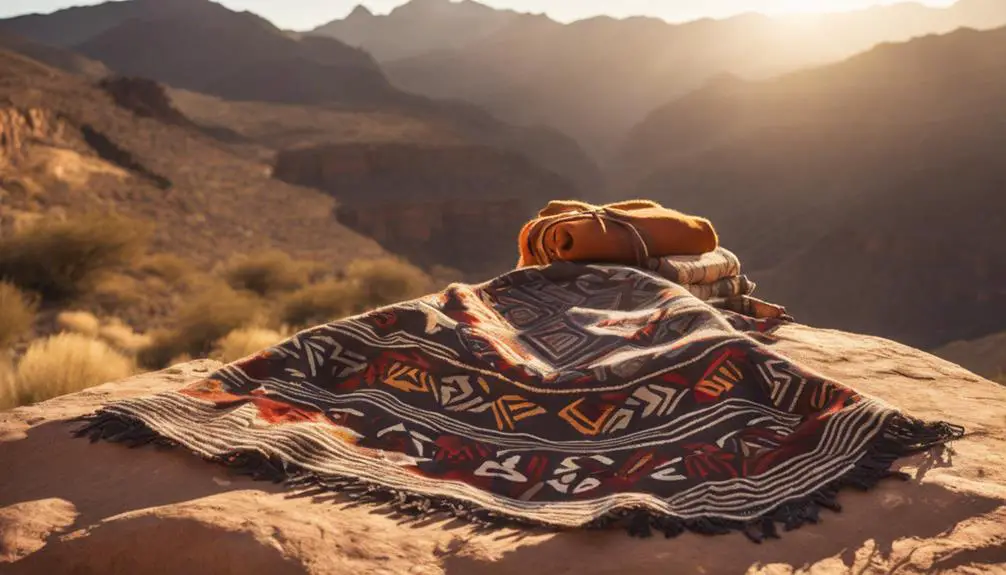
The etymology of the poncho reveals its rich cultural roots and historical significance. You might be surprised to learn that the term "poncho" likely comes from the Quechua word "punchu" and the Mapudungun word "pontro." This connection highlights the garment's deep indigenous origins, showcasing the cultural blend that has occurred over centuries. The poncho isn't just a piece of clothing; it's a symbol of heritage, particularly linked to the Mapuche culture.
In Mapuche tradition, specific geometric motifs, like the stepped-diamond, embody power and authority, further emphasizing the poncho's cultural importance. Historical research indicates that this versatile garment has been in use for over 1000 years, tracing back to pre-Inca cultures such as the Paracas and Nazca peoples.
Investigating the linguistic heritage of the poncho enriches your understanding of its role as a cultural artifact. It reflects a fascinating interplay of indigenous and colonial influences throughout history. As you explore deeper into the etymology of the poncho, you'll appreciate not just its practical use but also its profound connection to the legacy of the people who first wore it.
Historical Roots in Peru
Originating in the Andes Mountains, the poncho's history in Peru dates back to around 500 B.C. This remarkable garment was first embraced by the Paracas people, who inhabited regions of present-day Peru and Bolivia. The origins of ponchos in South America are rooted in practicality; crafted from durable alpaca fiber, they provided essential protection against the harsh climates of the Andes.
Over time, ponchos evolved beyond mere functional attire, becoming significant cultural symbols among indigenous people. For the Paracas culture, these garments played a crucial role in burial ceremonies, serving as offerings that symbolized rebirth and a connection to the afterlife. The intricate designs, often adorned with geometric patterns, indicated social status and authority, especially within pre-Inca and Inca civilizations.
As you explore the historical roots of ponchos in Peru, you can't help but appreciate their dual significance—both as a means of survival and a reflection of cultural identity. The legacy of these garments continues to resonate today, showcasing the artistry and traditions of the indigenous peoples who crafted them. Ponchos are, indeed, a fascinating reflection of Peru's rich history and vibrant culture.
Cultural Significance and Uses
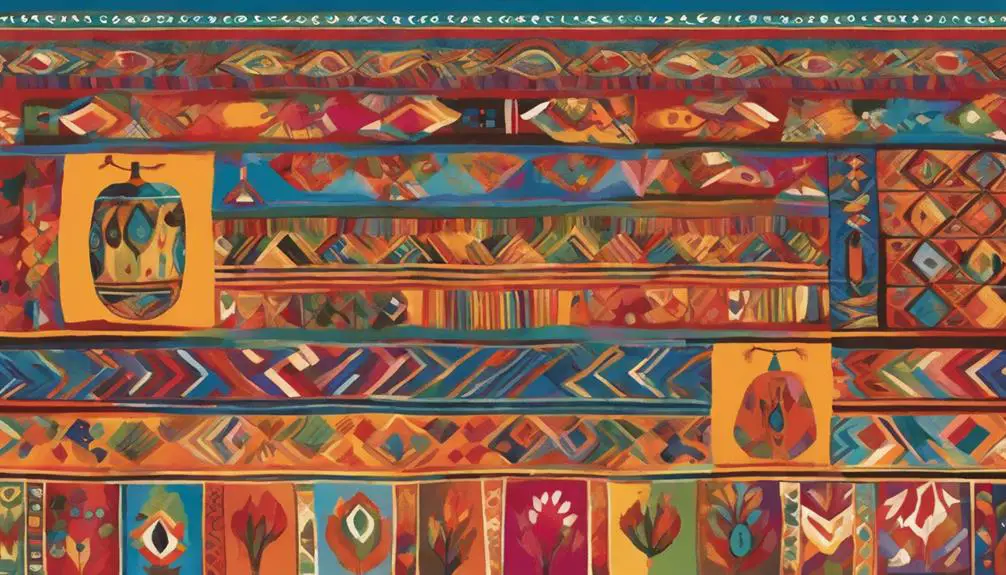
While ponchos began as practical garments in harsh climates, they've become deeply woven into the cultural fabric of indigenous communities across Latin America. The poncho holds immense cultural significance, particularly among the Mapuche people, who use vibrant patterns to express authority and social status. Traditionally made from wool or alpaca fiber, these garments were not just for warmth; they served essential roles in ceremonies and daily life.
In Mexico, you'll often spot ponchos during cultural events and festivals, where they reflect a rich tapestry of heritage and resilience. The distinctive designs and colors showcase the craftsmanship of communities dedicated to preserving their traditional clothing. For example, the Huanuy poncho, used for mourning, highlights the emotional depth associated with this garment, with specific colors symbolizing various sentiments.
Ponchos exemplify adaptability, transcending their original purpose to become fashionable pieces embraced globally. Whether worn for protection against harsh weather conditions or as a vibrant statement at a celebration, the poncho continues to represent a connection to roots and identity. Its diverse meanings and uses illustrate how this iconic garment stands as a powerful symbol of cultural heritage across Latin America.
Modern Fashion Trends
Ponchos have made a striking comeback in modern fashion, evolving from their utilitarian roots into stylish statement pieces. In the early 2000s, this versatile garment shifted into a fashion favorite embraced by designers worldwide. Today, you'll find ponchos crafted from a variety of materials, including synthetic textiles, cashmere, and acrylic, making them suitable for both casual and formal occasions. The revival of vintage styles has sparked interest in the sustainable fashion movement, as tailoring vintage clothing not only preserves unique garments but also minimizes textile waste.
Fashion trends now emphasize layering techniques, encouraging you to mix and match ponchos with multiple colors and textures. This bold approach allows you to showcase ethnic patterns and unique details, making your outfit truly stand out. Plus, ponchos have gained popularity across genders and age groups, with designs that cater to all body types. Reversible options further enhance their versatility, giving you more styling choices.
High-profile figures, including celebrities and fashion icons, have been instrumental in popularizing ponchos on runways and in the media. Their influence solidifies the poncho's status as a contemporary fashion staple that transcends trends. So, whether you're dressing up or down, a poncho can effortlessly elevate your wardrobe and keep you on-trend, combining comfort with chicness in every look you create!
Styling the Poncho
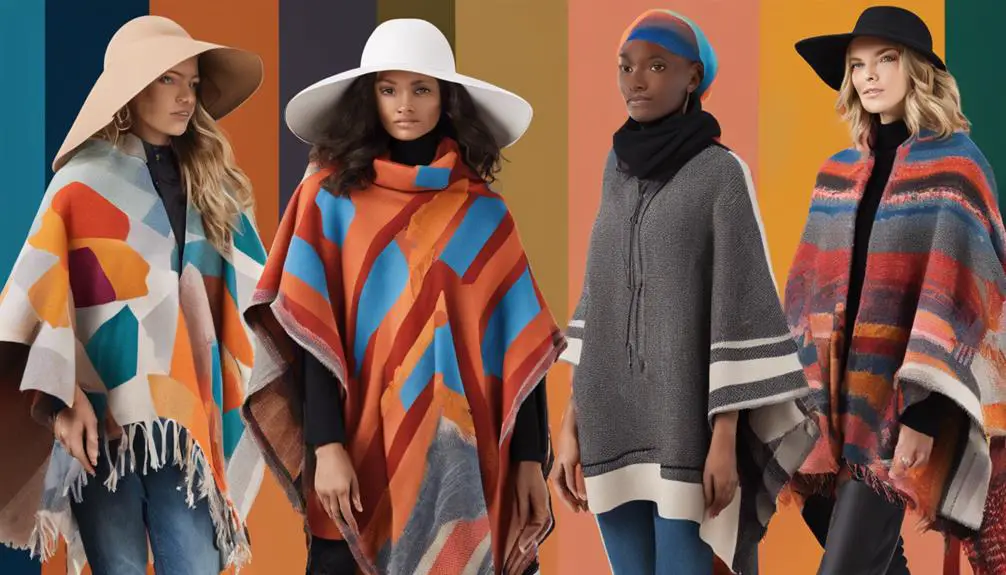
Styling a poncho opens up a world of versatile fashion pairings, making it a staple for every wardrobe. You can effortlessly shift from a casual day out to a chic evening gathering by mixing textures and colors, while seasonal styling tips can help you adapt your look to any climate. Whether you choose to layer it over fitted bottoms for a sleek silhouette or embrace bold prints, the poncho's adaptability truly shines, inviting you to express your unique style with confidence.
Versatile Fashion Pairings
In today's fashion landscape, ponchos stand out as a chic and adaptable choice that can elevate any outfit. Their versatility allows you to style them for both casual and formal occasions, showcasing their adaptability as a must-have fashion piece. To achieve stylish pairings, consider teaming your poncho with fitted bottoms like tailored pants or skinny jeans; this balances the silhouette and avoids the bulkiness that oversized backpacks can add.
Modern trends encourage you to experiment with prints and colors, so don't shy away from mixing patterns or incorporating vibrant ethnic designs. Ponchos also come in reversible options, making them an inclusive choice for everyone, regardless of body type or gender. The influence of celebrities, like Jason Momoa, has helped popularize ponchos on designer runways, reinforcing their luxurious vintage appeal and contemporary relevance.
Seasonal Styling Tips
When it comes to seasonal styling, ponchos offer endless possibilities that adapt beautifully to changing weather. You can start by draping a poncho over fitted bottoms, which not only balances your silhouette but also enhances your overall style without adding bulk. For a chic and stylish look, consider layering your poncho with different fabrics, like pairing a cozy wool poncho with a delicate silk scarf—this adds depth and dimension to your outfit during autumn and winter.
When accessorizing, go for minimalist options that allow your poncho's unique patterns and textures to shine. If you're feeling bold, don't shy away from mixing prints and colors; ethnic motifs and distinctive details are trending and can make your outfit truly stand out. Men might prefer straight-cut or cape-style ponchos, while wider designs with hoods offer a trendy twist.
Ultimately, the key to seasonal styling with ponchos lies in the combination of fabrics, the clever use of layering, and the right accessories. Embrace these tips, and you'll be ready to showcase your poncho in a stylish way all year round!
Ponchos for All Ages
Ponchos have become a go-to choice for people of all ages, blending functionality with style seamlessly. For children, ponchos offer a practical solution that keeps them warm and dry while engaging their sense of adventure. Available in various sizes and styles, these garments are designed with fun patterns and vibrant colors that make them irresistible for everyday wear or post-bathing use.
Many ponchos for kids feature hooded designs, providing added protection against rain and chilly weather, while quick-drying materials help prevent them from catching cold. Their versatility allows them to be worn during outdoor play or even at the pool, offering both warmth and privacy.
As ponchos gain popularity across genders and age groups, they've become recognized as stylish yet functional clothing for children. Parents appreciate how these garments enhance their kids' wardrobe options without sacrificing comfort. Whether your child is playing outside, heading to the beach, or simply lounging at home, a poncho is a practical choice that aligns with their active lifestyle. So, why not embrace the poncho trend? It's the perfect blend of style, warmth, and practicality that every child deserves!
Frequently Asked Questions
What Is the Origin of Ponchos?
Ponchos originated as traditional attire, showcasing indigenous craftsmanship with functional designs. Made from weather-resistant textile materials, they hold cultural significance and have inspired modern adaptations, leading to global variations that celebrate their rich heritage.
What Does the Poncho Symbolize?
The poncho symbolizes cultural significance and artistic expression. It's a fashion statement reflecting indigenous heritage, showcasing versatility appeal as both a protection symbol and an outdoor necessity, highlighting its historical evolution through time and trends.
What Is the History of the Rain Poncho?
Imagine a shield against the storm; the rain poncho's evolution showcases functional design and cultural significance. Modern adaptations embrace material innovations, turning weather protection into a fashionable statement for outdoor activities and adventurous spirits like yours.
What Are Some Interesting Facts About Ponchos?
You'll find poncho styles vary widely, reflecting cultural significance and historical uses. Modern adaptations showcase diverse fabric choices, while fashion trends highlight regional variations and celebrity endorsements, making the poncho an enduring and stylish wardrobe staple.
